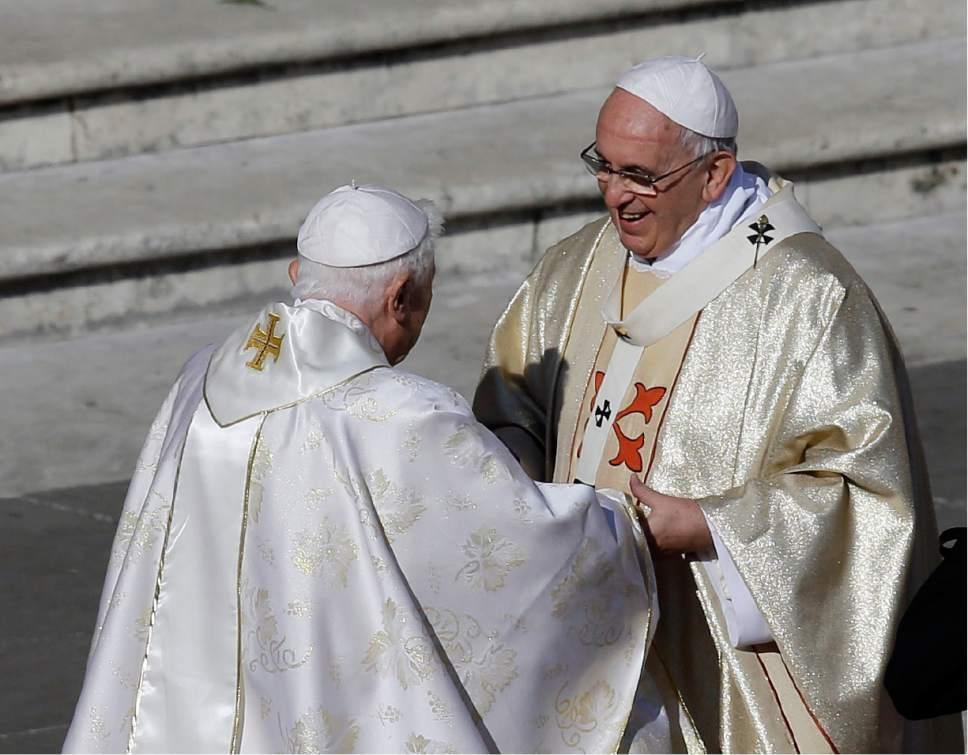|
Is Benedict XVI the REAL pope? 4 factors fuel Vatican conspiracy theories
By David Gibson
When Benedict XVI stunned Catholics by announcing that he would become the first pope in six centuries to resign, it immediately raised concerns — which were dismissed just as quickly — that an ex-pope around could undermine the legitimacy of the new pontiff. Now, nearly two years later, those fears are emerging again, fueled by the growing discontent of conservative Catholics with Benedict’s successor, Pope Francis, and by Benedict’s presence, if not quite as a player, in church debates Francis has sparked. "Benedict is hanging back for now, but there’s no doubt that he could easily become a figurehead for traditionalists hearkening back to the good old days," Notre Dame New Testament professor Candida Moss and Joel Baden, Old Testament professor at Yale Divinity School, warned in a Daily Beast column earlier this month. Hubert Wolf, a church historian at the University of Münster, echoed those thoughts in comments reported by a leading German newspaper last week, when he said there were worries that "around Francis and Benedict XVI, two competing power centers could come into being in the [Roman] Curia, with pope and anti-pope at the top of each." What’s fueling these fears? They seem outlandish, almost medieval. But there are at least four factors at work: 1. "There is another pope still living." New York Times columnist Ross Douthat, a Catholic who has become something of a spokesman for conservatives, made that point in a widely circulated column warning that Francis could provoke a schism on the right. His statement seems both obvious and perilous: If there’s "another pope," that means there is a potential rival to the throne. But the "two living popes" meme isn’t actually true, even though it keeps getting repeated. "There is only one pope and his name is Francis, whether people like him and the direction he is steering Roman Catholicism or not," Christopher Bellitto, a church historian at Kean University, wrote in a column for Reuters. "There is not more than one president or prime minister because predecessors are still alive," Bellitto wrote. "A person holds the office of president, prime minister or pope. When that person no longer holds that office, then that person is no longer president, prime minister or pope." 2. Conspiracy theories won’t die. Good luck telling that to some Catholics and conspiracy-lovers, who have propounded a number of theories they say undermine Francis’ claims to the papacy. Among them: Benedict used incorrect Latin in his formal resignation letter, so it is invalid; alternately, they say, the cardinals in the March 2013 conclave that elected Francis violated certain procedures, so his election is null and void. The speculation was so insistent that on the first anniversary of his resignation last February, an exasperated Benedict publicly called notions that he was still pope "simply absurd." 3. If he walks like a pope … Despite his protests, Benedict hasn’t exactly helped by keeping his papal name, continuing to wear the distinctive white papal cassock and taking the title — which he created for himself — of "pope emeritus." Some church experts say he could have instead gone back to a black cassock and his baptismal name, Joseph Ratzinger, and used the title "bishop emeritus of Rome" or simply Cardinal Ratzinger. "Juridically there is only one pope. A ‘pope emeritus’ cannot exist," Manuel Jesus Arroba, a professor of canon law at the Pontifical Lateran University, warned in the days after Benedict announced the innovation.
|
.
Any original material on these pages is copyright © BishopAccountability.org 2004. Reproduce freely with attribution.
